 W
WAbu Qubays is a former medieval castle and currently an inhabited village in northwestern Syria, administratively part of the Hama Governorate, located northwest of Hama. It is situated in the al-Ghab plain, west of the Orontes River. Nearby localities include Daliyah 21 kilometers to the west, al-Laqbah to the south, Deir Shamil to the southeast, Tell Salhab to the northeast and Nahr al-Bared further northeast. According to the Syria Central Bureau of Statistics (CBS), Abu Qubays had a population of 758 in the 2004 census. Its inhabitants are predominantly Alawites.
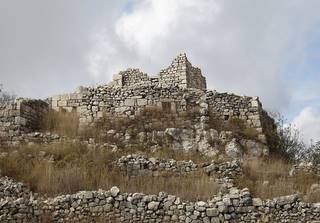 W
WAleika Castle or Aliqa Castle is located in Aliqa near Tartus at distance 85 km, it consists of two floor structures, a type of concentric castle. Historically it was under Syrian Nizari Isma'ili control, and had part during the crusades. Cemetery stones are found in the castle with Latin inscriptions, which confirms that fights took place here during the Crusades. The Mamluk Sultan Baibars is mentioned in the archives of the Syrian Tourism ministry.
 W
WBani Qahtan castle is found in the Syrian Coastal Mountains near Latakia city, 40 km far from it.
 W
WBourzey castle is called also Mirza castle,. It is located at the border of Syria coastal mountains and Ghab valley, 25 km away from Jisr al-Shughur, at altitude 450 m. The inscriptions and mentioning of the castle relate it to the Byzantine era in 11th century. Architecturally it has triangle shape, the western façade is 175 m, the eastern is 50 m. The southern and eastern façades are adjacent to deep gorges, but the western façade is the least steep. There is 21 towers and a small church on the surface.
 W
WChastel Blanc is a medieval structure in Safita, western Syria. It was built by the Knights Templar during the Crusades upon prior fortifications. Located on the middle hill of Safita's three hills, it offers a commanding view of the surrounding countryside, and was a major part of the network of Crusader fortifications in the area. From the roof, a view ranging see from the Mediterranean Sea to the snow-covered mountains of Lebanon, and County of Tripoli, is offered. From Chastel Blanc it would have been possible to see the Templar strongholds at Tartus and Ruad Island to the northwest, Chastel Rouge on the coastline to the southwest, Akkar to the south, and Krak des Chevaliers to the southeast.
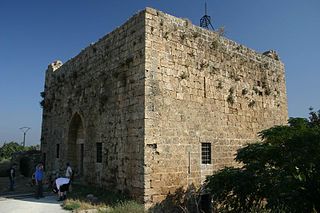 W
WChastel Rouge, also called Qal’at Yahmur is a small Crusader stronghold in the North West of Syria that belonged to the County of Tripoli. It is also identified as Castrum Rubrum mentioned in Latin texts. The castle stands in the village of Yahmur, at 12 kilometres' distance from Tartus and 10 kilometres from Safita, where the Tortosa and Chastel Blanc Crusader castles can be found.
 W
WKrak des Chevaliers, also called Crac des Chevaliers, Ḥiṣn al-Akrād, and formerly Crac de l'Ospital, is a Crusader castle in Syria and one of the most important preserved medieval castles in the world. The site was first inhabited in the 11th century by Kurdish troops garrisoned there by the Mirdasids. In 1142 it was given by Raymond II, Count of Tripoli, to the order of the Knights Hospitaller. It remained in their possession until it fell in 1271.
 W
WThe Citadel of Aleppo is a large medieval fortified palace in the centre of the old city of Aleppo, northern Syria. It is considered to be one of the oldest and largest castles in the world. Usage of the Citadel hill dates back at least to the middle of the 3rd millennium BC. Occupied by many civilizations over time – including the Greeks, Byzantines, Ayyubids, Mamluks and Ottomans – the majority of the construction as it stands today is thought to originate from the Ayyubid period. An extensive conservation work took place in the 2000s by the Aga Khan Trust for Culture, in collaboration with Aleppo Archeological Society. Dominating the city, the Citadel is part of the Ancient City of Aleppo, a UNESCO World Heritage Site since 1986. During the 2010s, the Citadel received significant damage during the lengthy Battle of Aleppo. It was reopened to the public in early 2017 with repairs to damaged parts underway.
 W
WThe Citadel of Damascus is a large medieval fortified palace and citadel in Damascus, Syria. It is part of the Ancient City of Damascus, which was listed as a UNESCO World Heritage Site in 1979.
 W
WThe Citadel of Homs, also known as Homs Castle or Qalaat Homs, is a historic building now mostly ruined in Homs, Syria. The citadel was built on top of an ancient tell southwest of the Old City, with remains dating back to the 3rd millennium BCE. The citadel is locally known as the "Citadel of Usama", named after Usama ibn Munqidh.
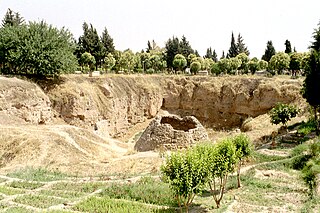 W
WHama Castle is located in Hama, Syria, Located on the Orontes River.
 W
WList of the strongholds of the Nizari Ismaili state in Persia (Iran) and Syria.
 W
WAl-Kahf Castle or Castle of the Cave is a medieval Nizari Isma'ili castle located around 30 kilometres (19 mi) southeast of Margat, in the al-Ansariyah mountains in northwest Syria.
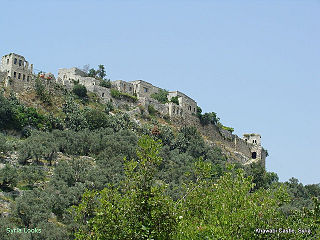 W
WKhawabi, also spelled Qala'at al-Khawabi is a village and medieval citadel in northwestern Syria, administratively part of the Tartus Governorate, located 20 kilometers northeast of Tartus and 12 kilometers east of al-Sawda. Khawabi is situated in a hilly area, surrounded by olive groves, in the Coastal Mountain Range. Nearby localities include al-Sawda and to the west, Al-Annazah to the northwest, al-Qamsiyah to the north, Brummanet Raad to the northeast, al-Shaykh Badr to the east, Khirbet al-Faras to the south and Bimalkah to the southwest.
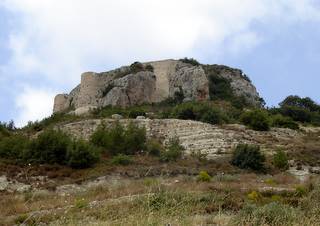 W
WMahalibeh castle is located at a high mountain summit near Lattakia, 40 km east of Syrian coast.
 W
WMargat, also known as Marqab,, is a castle near Baniyas, Syria, which was a Crusader fortress and one of the major strongholds of the Knights Hospitaller. It is located around 2 kilometres (1.2 mi) from the Mediterranean coast and approximately 6 kilometres (3.7 mi) south of Baniyas. The castle remained in a poor state of preservation until 2007 when some reconstruction and renovation began.
 W
WMasyaf Castle is a medieval structure in the town of Masyaf in Hama Governorate, Syria, situated in the Orontes Valley, approximately 40 kilometers to the west of Hama. It served to protect the trade routes to cities further inland such as Banyas. The castle itself stands on a platform about 20 meters above the surrounding plain. The citadel became famous as the stronghold from which Rashid ad-Din Sinan, known as the Old Man of the Mountain, ruled from 1166-1193. He was a leader of the Syrian branch of the Nizari Isma'ili sect, also known as the Assassins, and a figure in the history of the Crusades.
 W
WThe Nimrod Fortress or Nimrod Castle is a medieval Ayyubid castle situated on the southern slopes of Mount Hermon, on a ridge rising about 800 m above sea level. It overlooks the Golan Heights and was built with the purpose of guarding a major access route to Damascus against armies coming from the west.
 W
WPalmyra Castle, also known as Fakhr-al-Din al-Ma'ani Castle or Tadmur Castle, is a castle overlooking Palmyra in the province of Homs, Syria.
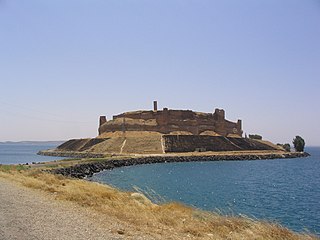 W
WQal'at Ja'bar is a castle on the left bank of Lake Assad in Raqqa Governorate, Syria. Its site, formerly a prominent hill-top overlooking the Euphrates Valley, is now an island in Lake Assad that can only be reached by an artificial causeway. Although the hilltop on which the castle sits was possibly already fortified in the 7th century, the current structures are primarily the work of Nur ad-Din, who rebuilt the castle from 1168 onwards. Since 1965, several excavations have been carried out in and around the castle, as well as restoration works of the walls and towers. The castle was a Turkish exclave between 1921 and 1973.
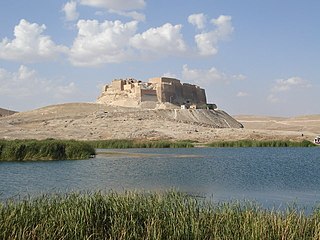 W
WQal'at Najm is a castle located on the right bank of the Euphrates, near the town of Manbij in north Syria. The castle probably stood on the site of an earlier Roman site and is known from Arabic texts since the 7th century CE. Reconstruction works were carried out in the castle by Nur ad-Din Zangi and Az-Zahir Ghazi during the 12th and early 13th centuries. The castle sits on a mound that is protected by a glacis and houses a palace-bath complex and a mosque.
 W
WQalaat al-Madiq is a town and medieval fortress in northwestern Syria, administratively part of the Hama Governorate, located northeast of Hama. It is situated in the al-Ghab plain, on the eastern bank of the Orontes River. Nearby localities include the district center al-Suqaylabiyah to the south, Bureij and Karnaz to the southeast, Kafr Nabudah to the east, al-Huwash to the north, Huwayjah al-Sallah and Shathah to the northwest and Al-Tuwayni and Ennab to the west. According to the Syria Central Bureau of Statistics (CBS), Qalaat al-Madiq had a population of 12,925 in the 2004 census. It is the administrative center and second largest locality in the Qalaat al-Madiq nahiyah ("subdistrict") which consisted of 40 localities with a collective population of 85,597 in 2004. The town's inhabitants are predominantly Sunni Muslims.
 W
WQasr al-Hayr al-Gharbi is a Syrian desert castle or qasr located 80 km south-west of Palmyra on the Damascus road. The castle is a twin palace of Qasr al-Hayr al-Sharqi, built by the Umayyad caliph Hisham ibn Abd al-Malik in 727 CE. It was built in the Byzantine architectural style.
 W
WQasr al-Hayr al-Sharqi is a castle (qasr) in the middle of the Syrian Desert. It was built by the Umayyad caliph Hisham ibn Abd al-Malik in 728-29 CE in an area rich in desert fauna. It was apparently used as a military and hunting outpost. The palace is the counterpart of Qasr al-Hayr al-Gharbi, a nearby castle palace built one year earlier.
 W
WQasr Ibn Wardan is a hamlet and 6th-century archaeological site located in the Syrian Desert, approximately 60 kilometres (37 mi) northeast from Hama and about 19 kilometres (12 mi) northeast of al-Hamraa. The hamlet is separated from the Byzantine-era ruins by a road, with the former situated to the east of the road and the ruins situated to the west. According to the Syria Central Bureau of Statistics (CBS), Qasr Ibn Wardan had a population of 467 in the 2004 census.
 W
WAl-Rahba, also known as Qal'at ar-Rahba, which translates as the "Citadel of al-Rahba", is a medieval Arab–Islamic fortress in Syria. It is located off the western banks of the Euphrates River, adjacent to the city of Mayadin and 42 kilometers (26 mi) southeast of Dayr az-Zawr. Situated atop a mound with an elevation of 244 meters (801 ft), al-Rahba oversees the Syrian Desert steppe and historically guarded the Euphrates valley. It has been described as "a fortress within a fortress"; it consists of an inner keep measuring 60 by 30 meters, protected by an enclosure measuring 270 by 95 meters. Al-Rahba is largely in ruins today as a result of erosion.
 W
WSahyun Castle, also known as the Castle of Saladin, is a medieval castle in northwestern Syria. It is located 7 km east of Al-Haffah town and 30 km east of the city of Latakia, in high mountainous terrain on a ridge between two deep ravines and surrounded by forest, the site has been fortified since at least the mid 10th century. In 975 the Byzantine Emperor John I Tzimiskes captured the site and it remained under Byzantine control until around 1108. Early in the 12th century the Franks assumed control of the site and it was part of the newly formed Crusader state of the Principality of Antioch. The Crusaders undertook an extensive building programme, giving the castle much of its current appearance. In 1188 it fell to the forces of Saladin after a three-day siege. The castle was again besieged in 1287, this time both defender and belligerent were Mamluks. In 2006, the castles of Qal'at Salah El-Din and Krak des Chevaliers were recognised as a World Heritage Site by UNESCO. The site is owned by the Syrian government.
 W
WShaizar or Shayzar is a town in northern Syria, administratively part of the Hama Governorate, located northwest of Hama. Nearby localities include, Mahardah, Tremseh, Kafr Hud, Khunayzir and Halfaya. According to the Syria Central Bureau of Statistics (CBS), Shaizar had a population of 5,953 in the 2004 census.
 W
WShmemis also ash-Shmemis, ash-Shmamis) is a castle located 3 km north west of Salamiyah and 30 km south east from Hama.